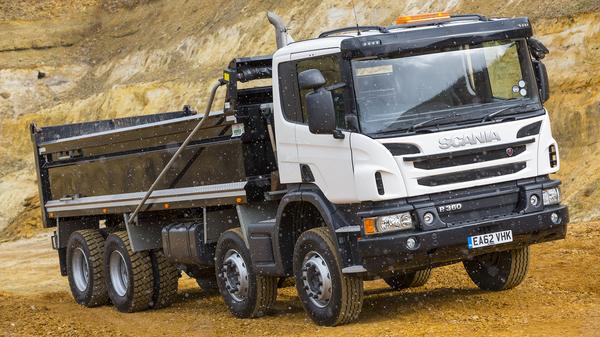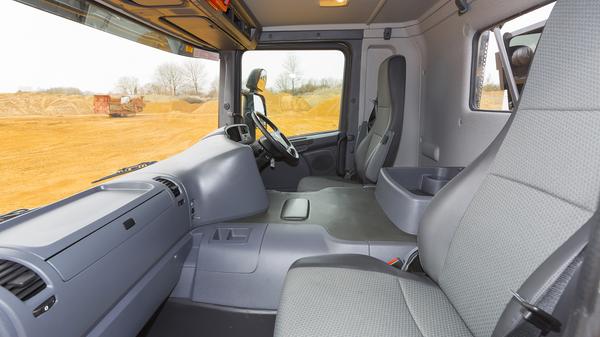Expert Review
Scania P Series review
As a multi-axle rigid the Scania P-series has no equal; lightweight, desirable and a willing workhorse.


Words by: Kevin Swallow
Published on 26 July 2019 | 0 min read
The Autotrader expert verdict:
4.1
Within the construction industry it has found a place on the fleets of multinationals and owner-drivers alike. Replaced by the XT (eXtra Tough) in 2016.
Reasons to buy:
- Reputation
- Evolving driveline
- Payload
Engines
The Euro-3 entry-level engine for the P-series was the 8.9-litre (DC-09) boasting 230, 270 and 310hp. Alternatively an operator could choose the 10.6-litre six-cylinder (DC-11) with a choice of 340 and 380hp power ratings or the 11.7-litre (DC-12) six-cylinder 420hp engine.
Exhaust gas recirculation (EGR) was fully deployed in 2006 for Euro-4 engines with some significant revamps; the DC-09 remained the same; the DC-11 was dropped; and the DC-12 could be ordered with 340, 380 and 420hp.
Scania made the transition to Euro-5 emission standards over the course of 2008 and 2009. It retained EGR for the DC-09 but it was now a beefed up 9.3-litre engine offering 230, 280 and 320hp. The DC-12 used selective catalytic reduction (SCR) as either a 380 or 420hp, and a new DC-13 12.7-litre six-cylinder engine using EGR was introduced at 360 and 400hp.
At Euro-6, which Scania launched in 2013, EGR was dropped for all the engines for SCR except for the V8 16.4-litre 730hp, which required both. With more power and torque it offered the DC-09 with 250, 280, 320 and 360hp, and the DC-13 versions at 370, 410 and 450hp.
Expert rating: 4/5
Transmission
For DC-09 Scania offered three gearboxes; the GR801 eight-speed range-change, the GR900 that came with a crawler and optional retarder, and the GRS890 14-speed with range-change and splitter, and retarder.
To go with the DC-11 there were a choice of four including the GR900, and three 14-speed options; GRS890, GRS900 and the GRS900 with overdrive. The retarder and Opticruise were options for each 14-speed gearbox.
Unlike its competitors, Scania retained a third pedal (yes, the clutch) for its automated gearboxes, which the driver used to start and stop the truck.
In 2009, it revamped Opticruise into a traditional two-pedal set up. Two years later Scania refined its Opticruise software and added an economy mode that softened the engines response and disabled kickdown.
Expert rating: 4/5

Cabs
Transition from the 4-series to the new P-series cabs was subtle. A few well-placed badges and a minor tweak to the interior was about it. Operators could choose from four cabs; day, extended day, low-roof sleeper and high-roof sleeper.
In 2008 with the phased introduction of the Euro-5 engines the high-roof sleeper became part of the newly introduced G-series, a mid-range choice of cabs with a higher cab floor height for bigger engines, and a 310mm engine tunnel, 120mm lower than the P-series.
The G-series would take around a third of sales from P-series, mainly from those operators who travelled beyond the local area and owner-drivers.
Scania modified the exterior the following year with a new grille and bumper with reshaped air-intakes, to allow greater airflow through the engine compartment in preparation for the next generation of Euro-6 engines. These cabs remained in place until the arrival of the next generation XT in 2016.
Expert rating: 4/5
Comfort and storage
The driving position has always veered towards the functional with anecdotal criticism by drivers usually bemoaning the lack of leg space, insufficient storage and easily damaged surfaces.
Updated versions of the P-series with new dashboard included better quality surface materials, and a centre console with handy storage boxes, USB and phone connections.
One area it failed to address was external lockers for gloves or hard-hats or even ancillary equipment. Even the sleeper cabs remained devoid of external storage, with drivers using the bunk or passenger footwell to store their day-to-day provisions. It led to a generation of home-made external storage solutions.
Expert rating: 3/5
Safety
Like its competitors, safety is an integral part of the Scania product. Since 2006 the Swedes have focussed on the driver as the critical part in road safety, first with the Driver Alert (now the Driver Attention Support) to monitor the driver's attention level.
Three years later it added the Scania Driver Support system, which retained safety but also focussed on acceleration, anticipation, and driving over undulating terrain.
An integrated tyre pressure monitoring system was introduced in 2011 to improve rolling resistance, fuel economy, manage tyre wear and help prevent accidents.
With the launch of Euro-6 Scania added electronic stability programs to avoid vehicle roll-over, advanced emergency braking system that uses a camera and radar to identify stationary and slow-moving obstacles, and lane departure warning system.
Expert rating: 4/5
Handling
The best combination for maximum performance and payload is the DC-13 with 450hp at Euro-6. It delivers 2,350Nm torque that provides consistency in terms of speed, with plenty of depth when climbing short and longer hills.
Since Scania moved to a 12.7-litre engine, its continually moved towards lower revs. The first generation of Euro-6s happily lug down to 1,000rpm without losing interest.
Fully freighted and from a standing start it works quickly through the gearbox, which gives the driver a sense of progress. Fitted with an eight-speed manual direct-drive transmission, still a firm favourite, it provides excellent control in situations where the driver is working at close-quarters with plant and machinery, and slow manoeuvring on site.
Expert rating: 5/5
Running costs
When it comes to bulk transport, weight is everything. For most it trumped concerns over poor fuel returns through Euro-4 and -5, and even now those tippers that pop up in the second-hand market still sell at a premium.
For Euro-6 operators get the best of both worlds; enough options for a genuinely light chassis-cab and impressive fuel returns. Some operators have reported that with two drive axles and 32 tonne gross vehicle weight (GVW) the benefits of Eco-roll and Scania Active Prediction is significantly less than a 44 tonne GVW truck and trailer with one drive axle.
Expert rating: 4/5
Price and residuals
For all the reasons operators cite for not buying a Scania – expensive to buy and maintain through the dealer network – the payoff is a return on investment thanks to the strong residuals. Often the engine, cab, gearbox and its overall condition are overlooked for its ability to carry more and make less trips than its contemporaries.
Disposing of a Scania P-series remains a sellers’ market, although it’s residuals softened a little when the G-series was introduced in 2008, with the latter pitting desirability against functionality.
Most of the Euro-6s coming back onto the AutoTrader Trucks marketplace are ‘P410s’ with a smattering of P450s.
For all the reasons operators cite for not buying a Scania – expensive to buy and maintain through the dealer network – the payoff is a return on investment thanks to the strong residuals. Often the engine, cab, gearbox and its overall condition are overlooked for its ability to carry more and make less trips than its contemporaries.
Disposing of a Scania P-series remains a sellers’ market, although it’s residuals softened a little when the G-series was introduced in 2008, with the latter pitting desirability against functionality.
Most of the Euro-6s coming back onto the AutoTrader Trucks marketplace are ‘P410s’ with a smattering of P450s.
Expert rating: 5/5
Warranties and dealer networks
For new sales Scania has the factory-issued one-year warranty with a second year for the driveline. However, it has now worked a two-year repair and maintenance package into the purchase price.
Within the dealer network are wholly owned dealerships and large independent groups; in total there is 89 service points across the UK and Northern Ireland.
Expert rating: 3/5
Why buy?
Scania is one of the three leading suppliers of 8x4 chassis-cabs in the UK because it is lightweight and manages to combine appeal with efficiency.
The arrival of G-series allowed some operators to add glamour and internal space to their eight-wheelers, but operators who originally bought P-series for its ability to work have remained loyal. Hauliers, owner-drivers and drivers like to put their trust in something that delivers, and in that respect, the P-series has a proven track record.
Browse all our new trucks here.
Expert rating: 5/5